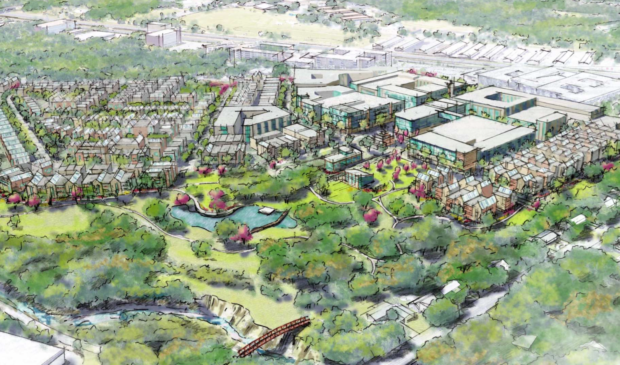Grove PUD fight lives to see another day
Friday, September 23, 2016 by
Jack Craver It was already 9:45 p.m. on Thursday when City Council kicked off its first public hearing on the Grove at Shoal Creek, a controversial planned unit development proposed for a 75-acre lot in Central Austin, and Mayor Steve Adler announced that 179 people were signed up to speak their minds on the project.
A large contingent of green-clad project supporters, mostly residents of the nearby Westminster retirement community, had shown up at 2 p.m., when the hearing was scheduled to begin, but only a smattering of green remained by the time Council actually took up the matter. Instead, the room was dominated by white-shirted opponents of the project affiliated with the Bull Creek Road Coalition, who showed up en masse in the evening.
Supporters and opponents of the project trotted out many of the same arguments they have made at previous marathon public hearings on the subject before the Parks and Recreation Board, the Environmental Commission and the Zoning and Platting Commission.
Anticipating that public testimony would likely last until the early morning hours, Council members were likely pleasantly surprised when the last citizen speaker came to the podium shortly after midnight. Earlier in the evening, a representative from the Bull Creek Road Coalition announced that many of those in attendance had decided not to speak after Adler made clear that Council would not take any action on the project until a later date.
Council voted just before 12:30 a.m. to postpone further action until Oct. 20.
Although Council did not begin formal debate on the project, the questions from the dais of city staff hinted at familiar divisions over development issues.
Mayor Pro Tem Kathie Tovo challenged the “baseline” square footage that city staff had estimated would be allowed under traditional zoning on the property, saying that by her own calculation based on nearby zoning, the parcel would be allowed only 1.3 million square feet of development, compared to the 1.9 million staff calculated. The lower the baseline, she argued, the more the city would be able to demand of the applicant for any additional density it is granted as part of the PUD, such as affordable housing.
Council Member Greg Casar responded that he also wanted to demand as much affordable housing as possible from the development, but didn’t see the significance in establishing what the square footage limit would be under conventional zoning. The beauty of a PUD, he pointed out, was that Council could demand whatever it wanted of the applicant.
Council Member Leslie Pool, whose district borders the development site, unveiled a number of amendments before the hearing that mirrored requests that have been repeatedly made by the Bull Creek Road Coalition, of which she was formerly a founding member.
Pool proposed raising the number of residential units on the property from 1,515 units to 1,655 units but reducing the commercial and retail space from 360,000 square feet to 215,000 square feet. She also proposed capping the vehicle trips generated by the development at 18,000 rather than the roughly 24,000 currently proposed, that a larger percentage of the units be reserved for those at 60 percent and 80 percent of the median family income and that the development include more parkland.
Council Member Sheri Gallo, in whose district the site is located, announced via press release during the hearing that the project developer, ARG Bull Creek Ltd., had agreed to provide more park space, upping its commitment from 12.88 acres to 14.13 acres.
Both Pool and Gallo are running for re-election and are facing opponents who are on the opposite side of the Grove. Pool’s opponent, Natalie Gauldin, is an active proponent of the development, and one of Gallo’s opponents, Alison Alter, was Gallo’s appointee to the Parks and Recreation Board before she declared her intention to challenge Gallo largely based on her opposition to the project as currently proposed.
Council Member Ann Kitchen expressed concerns about whether even the most heavily discounted units at the site would be accessible to low-wage workers in the area, such as personal care attendants at the nearby Westminster retirement community. Currently the developers propose reserving 108 units, some for those with incomes at 60 percent of area median and some for those at 80 percent of the median. Many low-wage workers are far below that level, she pointed out.
“At 60 percent and 80 percent, I’m concerned that none of them could (afford housing),” she said.
Council Member Delia Garza wondered whether the development would be able to accommodate housing for even lower income levels — perhaps 30 percent MFI — by raising the income limit for some of the other affordable units. Even those at 100 percent of MFI, she said, don’t have nearly the money needed to rent market-rate housing in the area.
Rendering provided by Bull Creek ARG Ltd.
The Austin Monitor’s work is made possible by donations from the community. Though our reporting covers donors from time to time, we are careful to keep business and editorial efforts separate while maintaining transparency. A complete list of donors is available here, and our code of ethics is explained here.
You're a community leader
And we’re honored you look to us for serious, in-depth news. You know a strong community needs local and dedicated watchdog reporting. We’re here for you and that won’t change. Now will you take the powerful next step and support our nonprofit news organization?



